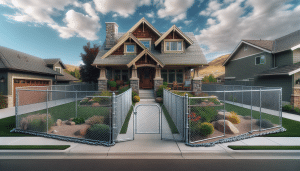Vinyl fencing is a popular choice for many homeowners thanks to its durability and low maintenance. However, even the sturdiest fences can suffer damage from harsh weather, accidents, or general wear and tear. As Logan Fence Company, we’ve seen it all and are here to share our expertise. This comprehensive guide is designed to help you tackle Vinyl Fence repair like a pro, ensuring your fence continues to enhance your property for years to come.
Contents
- 1 Understanding Vinyl Fence Damage
- 2 Preparation is Key
- 3 Simple Crack and Hole Repairs
- 4 Dealing With Leaning Sections
- 5 Replacing Damaged Panels
- 6 DIY or Professional Help?
- 7 Maintenance to Prevent Future Damage
- 8 Tools and Materials Needed for Basic Repairs Before you begin, make sure you have PVC glue, a vinyl fence patch kit, a heat gun for difficult bends or warps, cleaning solutions, and a set of basic tools like screwdrivers and pliers. Cleaning Before Repairing Clean the damaged area thoroughly with soap and water or a specialized fencing cleaner to ensure the repair materials adhere properly and the damage can be assessed accurately. Regular Inspection Periodically inspect your fence for signs of damage or wear. Catching issues early can make repairs easier and less costly in the long run. Protective Measures Consider adding extra protection to vulnerable areas of your fence, such as corners near driveways or areas frequently exposed to harsh weather. Professional Assessment If in doubt, don’t hesitate to contact professionals for an assessment. Sometimes, a problem might be more severe than it appears, requiring expert intervention.
Understanding Vinyl Fence Damage
Vinyl fences are praised for their resilience and longevity, but they’re not invincible. Weather conditions can play a significant role in the wear and tear of your fence. From the blistering sun causing discoloration to heavy snow putting pressure on panels. Additionally, accidental impacts from vehicles or lawn equipment can lead to cracks or breaks. Recognizing what caused the damage is the first step towards a successful repair.
It’s also important to note the variance in damage types. Cracks and holes require different approaches than issues like leaning or panel detachment. By carefully assessing the extent and type of damage, you can plan the most effective repair strategy.
Preparation is Key
Before diving into repairs, it’s crucial to prepare. Gather the necessary tools and materials such as PVC glue, spare parts, cleaning solutions, and possibly a heat gun for more complex issues. Ensuring you have everything on hand will streamline the repair process.
Equally important is cleaning the damaged area. Dirt and debris can interfere with repairs, especially when adhesives are involved. A thorough cleaning not only helps the repair materials to adhere better but also allows you to get a clearer view of the damage.
Simple Crack and Hole Repairs
Minor damage such as small cracks or holes can often be repaired with a bit of PVC glue or vinyl patching compound. For cracks, applying a generous amount of glue and allowing it to dry completely often does the trick. For holes, a vinyl patch kit may be required to fill the space effectively.
When dealing with these smaller repairs, patience is key. Allow enough drying time and avoid putting stress on the repaired area to ensure a lasting fix. It may seem simple, but these small repairs extend the life of your fence significantly when done correctly.
Dealing With Leaning Sections
Sections of your fence may start leaning due to a variety of reasons, including soil erosion or weakened posts. This issue not only affects the appearance of your fence but can also lead to more significant damage if not addressed.
Correcting a leaning fence often involves straightening and reinforcing the affected posts. This might mean excavating around the posts to reset them or adding additional support such as concrete for stabilization. Taking action as soon as you notice leaning can prevent more extensive repairs later.
Replacing Damaged Panels
In some cases, the damage may be extensive enough that the best solution is to replace the affected panels entirely. This is often the case for large cracks, holes, or breaks that are beyond simple repair.
Replacement involves removing the damaged panel and installing a new one. While this might sound straightforward, matching the new panel to your existing fence in terms of color and style can sometimes be a challenge, especially for older fences. Working with a professional can help ensure seamless replacements.
DIY or Professional Help?
While many vinyl fence repairs can be completed as DIY projects, there are times when it might be best to call in professionals. Complex issues such as foundation problems or extensive damage might require expertise and equipment beyond the average homeowner’s scope.
Additionally, professionals can often complete repairs more quickly and efficiently, minimizing the impact on your property. We recommend assessing the extent of the damage and your comfort level with the repairs before deciding which route to take.
Maintenance to Prevent Future Damage
One of the best ways to minimize repairs is through regular maintenance. This means keeping your fence clean, periodically checking for and addressing minor damages before they become major issues.
It’s also wise to take preventive measures such as installing protective barriers around your fence to guard against accidental impacts. Simple steps taken today can save you considerable time and money on future repairs.
- Tools and Materials Needed for Basic Repairs
Before you begin, make sure you have PVC glue, a vinyl fence patch kit, a heat gun for difficult bends or warps, cleaning solutions, and a set of basic tools like screwdrivers and pliers.
- Cleaning Before Repairing
Clean the damaged area thoroughly with soap and water or a specialized fencing cleaner to ensure the repair materials adhere properly and the damage can be assessed accurately.
- Regular Inspection
Periodically inspect your fence for signs of damage or wear. Catching issues early can make repairs easier and less costly in the long run.
- Protective Measures
Consider adding extra protection to vulnerable areas of your fence, such as corners near driveways or areas frequently exposed to harsh weather.
- Professional Assessment
If in doubt, don’t hesitate to contact professionals for an assessment. Sometimes, a problem might be more severe than it appears, requiring expert intervention.
Before you begin, make sure you have PVC glue, a vinyl fence patch kit, a heat gun for difficult bends or warps, cleaning solutions, and a set of basic tools like screwdrivers and pliers.
Clean the damaged area thoroughly with soap and water or a specialized fencing cleaner to ensure the repair materials adhere properly and the damage can be assessed accurately.
Periodically inspect your fence for signs of damage or wear. Catching issues early can make repairs easier and less costly in the long run.
Consider adding extra protection to vulnerable areas of your fence, such as corners near driveways or areas frequently exposed to harsh weather.
If in doubt, don’t hesitate to contact professionals for an assessment. Sometimes, a problem might be more severe than it appears, requiring expert intervention.
In conclusion, vinyl fence repair does not have to be a daunting task. With the right tools, materials, and knowledge, many common issues can be effectively addressed, ensuring your fence remains a beautiful and durable boundary for your property. And remember, for repairs that feel out of your league or for advice on maintaining your vinyl fence, you can always reach out to us by phone at 435-383-5152 or Request a Free Quote. Tackling those repairs sooner rather than later will help keep your fence in tip-top shape for years to come.




